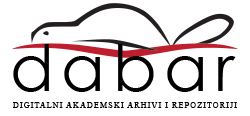Title Utjecaj glazbe na likovni izričaj predškolskog djeteta Title (english) The influence of music on the artistic expression of preschool children Author Maja Lucija Lisek Mentor Blaženka Bačlija Sušić (mentor)Mentor Martina Mičija (sumentor)Committee member Silvia Rogošić (predsjednik povjerenstva)Committee member Blaženka Bačlija Sušić (član povjerenstva)Committee member Martina Mičija (član povjerenstva)Granter University of Zagreb Defense date and country 2024-09-25, Croatia Scientific / art field, FIELD OF ART Scientific / art field, FIELD OF ART Abstract Istraživanja ukazuju da glazba i glazbeno obrazovanje imaju iznimni učinak na opći razvoj djeteta. Međutim još nisu u potpunosti poznati odgovori na pitanje na koji način i u kojoj količini specifični oblici glazbenih iskustava u raznim razdobljima djetinjstva utječu na dijete. Utvrđeno je da glazba može pozitivno, ali i negativno utjecati na razvoj djeteta, a isto tako i da može proširiti dječji vokabular, produžiti koncentraciju te razviti složenost govora. Djeca su od samog rođenja okružena glazbom, od prvih uspavanki, do brojalica, preko lakših do kompleksnijih pjesmica koje često budu popraćene raznim koreografijama ili proizvoljnim plesom. Sve te glazbene igre utječu na razvoj motoričke sposobnosti, osjećaja za umjetnost i stvaralaštvo, potiče se razvoj centra za ravnotežu i slično. U odgoju djece vrlo je bitno poticati njihovu maštu i dati im potpunu slobodu izražavanja, pa tako i zamišljanje zvuka kao određene boje ili oblika. Postoje mnoge vježbe zamišljanja uz glazbu, kako djeca zamišljaju određenu skladbu te to i prenesu na papir u obliku likovnog rada.
Cilj ovog završnog rada je prikazati ulogu glazbe u dječjem razvoju, s posebnim fokusom na njezin doprinos dječjem likovnom stvaralaštvu. Kroz provedbu projekta, kao primjera dobre prakse, istražena je uloga glazbe u obogaćivanju dječjeg likovnog izričaja uz poticanje djece na istraživanje raznih oblika i boja. S obzirom na to da su djeca spontano, tijekom likovnog izražavanja uz glazbu koristila krug s kojim su se ranije upoznala, povezivanje ovih područja ujedno ukazuje na integriranu prirodu djetetova učenja koju ističe Nacionalni kurikulum za rani i predškolski odgoj i obrazovanje (NKRPOO, 2014). Slušanje glazbe pobuđuje određene emocije kod djeteta koje ono može izraziti putem likovnog izražavanja što pridonosi njegovom cjelokupnom razvoju.
Abstract (english) Researches show that music and music education have an exceptional effect on child's general development. However, the answers to the questions how and to what extent specific forms of musical experiences in various periods of childhood affect the child are not yet fully known. It has been established that music can have a positive as well as a negative impact on a child's development, as well as that it can expand a child's vocabulary, prolong concentration and develop the complexity of speech. From birth, children are surrounded by music, from the first lullabies, to counting, through easier to more complex songs that are often accompanied by various choreographies or arbitrary dance. All these musical games affect the development of motor skills, a sense for art and creativity, the development of the center for balance and similar is encouraged. When raising children, it is very important to encourage their imagination and give them complete freedom of expression, including imagining sound as a certain color or shape. There are many exercises of imagination with music, how children imagine a certain composition and transfer it to paper in the form of art work.
The goal of this paper is to show the role of music in children's development, with a special focus on its contribution to children's art. Through the implementation of the project, as an example of good practice, the role of music in enriching children's artistic expression was investigated while encouraging children to explore various shapes and colors. Considering that the children spontaneously used the circle with which they were introduced earlier during artistic expression with music, the connection of these areas also indicates the integrated nature of the child's learning, which is emphasized by the National Curriculum for Early and Preschool Education (NKRPOO, 2014). Listening to music arouses certain emotions in the child, which they can express through artistic expression, which contributes to their overall development.
Keywords
glazbeno obrazovanje
likovno obrazovanje
dječji razvoj
glazba
djetinjstvo
Keywords (english)
music education
art education
child development
music
childhood
Language croatian URN:NBN urn:nbn:hr:147:665208 Study programme Title: Undergraduate University Study of Early and Preschool Education Type of resource Text File origin Born digital Access conditions Open access Terms of use Created on 2025-04-10 14:39:51

